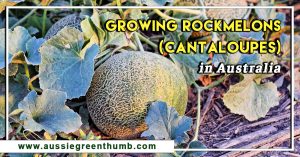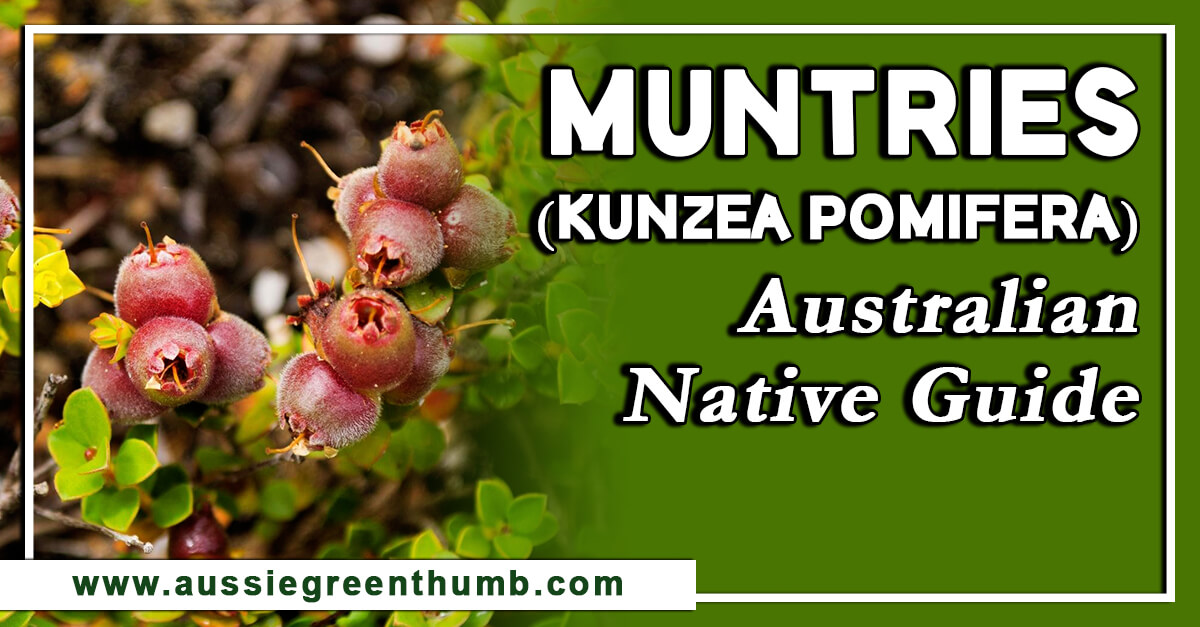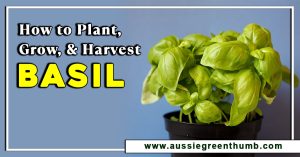Viburnum odoratissimum is one of the most iconic scented hedges you can grow in Australia, requiring very little care, and happy in almost any condition, but did you know you can grow this fragrant shrub as a tree?
In this article, we’re going to share our favourite tips and tricks for growing Viburnum odoratissimum in Australia, including how and when to mulch, the vast differences between the hedges we’re all familiar with, and the beautiful tree it grows into in its natural habitat.
More...
Genus: | Viburnum |
|---|---|
Species: | V. odoratissimum |
Family: | Adoxaceae |
Common Names: | Sweet viburnum |
Location: | Outdoor |
Type: | Shrub or small tree |
Growth: | 2m x 2m |
Sun requirements: | Full sun to part shade |
Foliage Colour: | Green |
Flower Colour: | White |
Flowering: | Mid-late Spring |
Fruit: | Red berries in summer, turning black in autumn (poisonous) |
Maintenance level: | Low |
Poisonous for pets: | Non-toxic to cats and dogs |
What is Viburnum odoratissimum?

Viburnum odoratissimum, commonly called sweet viburnum, is a variety of viburnum prized for its powerful sweet fragrance that fills even the largest gardens with its scent in late spring and early summer.
Typically grown as a shrub, this evergreen plant actually prefers to grow under its own devices as a tree, and can reach up to eight metres tall with a similar spread.
Thanks to its slow-growing nature, it’s an easy low-maintenance tree for small gardens, and is unlikely to self-seed in our warmer climate so is very easy to control.
Natural Habitat of Viburnum odoratissimum
Viburnum odoratissimum is native to eastern Asia and can be found growing wild throughout China, Japan, Taiwan, Korea, Vietnam, Thailand, Myanmar, the Philippines and the Himalayan region of India.
Like most plants grown in East Asia, they thrive in humid conditions, and enjoy lots of sunshine, making them perfect for our gardens in Australia. In recent years a subspecies called V. awabuki has been identified as distinct thanks to its glossy, waxy leaves that are held in full colour all year round.
What is Viburnum awabuki?
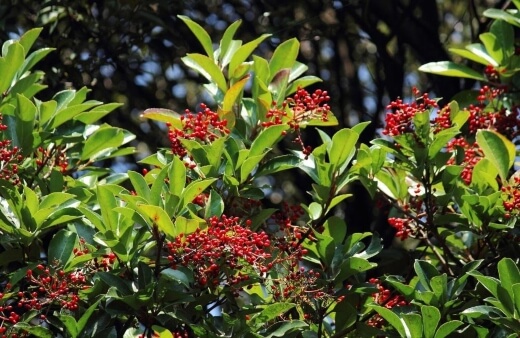
Viburnum odoratissimum var. awabuki, or Viburnum awabuki for short, is a glossy evergreen variant of V. odoratissimum. Their glossy leaves hold moisture better than their matt leaves counterparts known only by their species name (V. odoratissimum) so make even better low-maintenance plants for Australian gardens.
The one really big benefit of the glossy leaved variety of V. odoratissimum is that it is much less likely to be eaten by ants, who love to munch on all matt-leaved viburnums, no matter how they smell.
How to Grow Viburnum odoratissimum
Viburnum odoratissimum is an evergreen shrub that grows best outdoors, in full sun, with moist soil and reasonable drainage, so finding the right position is key to your success, and beyond that, it’s all about simple maintenance.
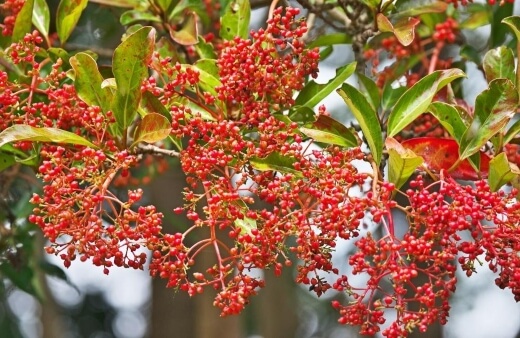
Best Soil for Viburnum odoratissimum
The best soil for V. odoratissimum is a classic loamy clay. The free-draining loamy structure coupled with moisture retention of clay makes the perfect soil for most trees and shrubs, but viburnum isn’t fussy and will usually cope happily provided they aren’t subjected to complete drought.
Viburnum odoratissimum will grow in acid, alkaline, or neutral soils, but like all fragrant plants produce more scent on slightly acidic soils, which helps nutrient and mineral uptake at the roots.
Best Position for Sweet Viburnum
V. odoratissimum grows well in most positions, but will thrive in full sun, with shelter from the wind, either from the house or a fence, but when mature, the wind will cause little problem to this imposing tree.
For the first three years odoratissimum needs space to grow without interruption, so avoid underplanting, and mulch around its base to prevent weeds. Allow at least 0.5m around the base of the plant for roots to establish.


Get Your Free Guide:
Master Growing Australian Natives eBook
A Must Have Complete Guide for Every Australian Garden
Get Your Free Guide:
Master Growing Australian Natives eBook
A Must Have Complete Guide for Every Australian Garden
Viburnum odoratissimum Propagation from Cuttings

Viburnum does produce viable seeds in the form of berries, which are ripe and ready to sow when they turn black in autumn, but the easiest (and fastest) way to grow new plants is through greenwood cuttings.
Take semi-ripe greenwood cuttings from Viburnum odoratissimum in early or mid-summer when this year’s growth has had time to grow to 3-4” long, and have young leaves at its tip.
Trim any old large leaves, so there is 3” of stem to bury below the soil, and carefully cut off ½ of the youngest leaves to prevent evaporation. Follow that step by pushing your cuttings into a small plastic pot filled with a 50:50 mix of vermiculite and cutting compost.
Water well, then leave in a cold frame or greenhouse until new growth appears. For a more detailed guide on taking greenwood cuttings read our ultimate guide to taking cuttings.
Viburnum odoratissimum Care Tips
Mulching Viburnum odoratissimum
Mulch V. odoratissimum annually with any neutral compost, or well-rotted manure. There is no need to fertilise in the garden provided it is mulched annually.
If you don’t mulch, you can boost the nutrients for better fragrance with any flower focussed fertiliser, but I like liquid seaweed as a balanced organic feed for flowering shrubs.

Source: alpinenurseries.com.au
Watering Needs
Water well through periods of drought to keep leaves looking lush, and help the plant hold onto flowers into early summer. Provided there is weekly rainfall outdoors, and the soil around the base of the plant isn’t bone dry, there is no need to water.
Pruning Viburnum odoratissimum
V. odoratissimum requires little to no pruning, and should only ever be pruned to remove dead, damaged or diseased growth if you want it to grow according to its natural habit, into a tall and healthy tree.
To form hedges or more compact shrubs it is possible to restrict growth with an annual prune to retain its shape in late autumn.
To help you form that perfect hedge, be sure to check our product review and buying guide on best hedge shears and hedge trimmer in 2024.
For more extreme compaction, V. odoratissimum makes beautiful bonsai trees for the patio.
Viburnum odoratissimum Pests and Diseases
Viburnum is a tough plant, with very few pests or disease problems, particularly in Australia, but like any garden shrub, their new growth in spring is very susceptible to aphids and ants.
Aphids
V. odoratissimum occasionally suffers from aphids on new shoots in spring but they cause little harm. If you notice blackening tips on new growth, wash aphids off with a powerful hose
Ants
Ants adore viburnum of all varieties, but once your plants have been established they will cause little to no harm to the plant. For young plants, rub a small amount of Vaseline over the trunk once every 4 to 8 weeks in spring and summer to stop them from climbing.
Dry leaves
The only common problem with V. odoratissimum is dry leaves from wind or drought. They are completely happy in full sun but need good moisture through summer.
Unlike most viburnums that can cope with dry shade all year round, V. odoratissimum is a little pickier about its position.
While drought can cause dry or frazzled leaves, the most common cause is actually wind. They prefer a sheltered position and should be kept well away from any sea breeze as the salty winds can dry out their luscious leaves.
Viburnum odoratissimum FAQs
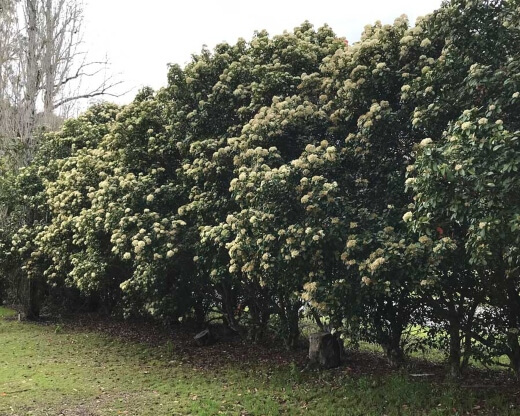
Source: gardensonline
How fast does Viburnum odoratissimum grow?
Sweet viburnum will grow between 12 and 24 inches per year. Mature sweet viburnum hedges will respond to winter pruning with a flush of new growth in spring, while sweet viburnum that has grown into its tree form, will grow more slowly without any pruning required.
Is Viburnum odoratissimum frost tolerant?
Sweet viburnum can tolerate frosts down to -10°C so is perfectly happy throughout Australia even in the coldest winters. Young plants should be protected from frost until they reach at least 1 ft. tall, but by the time you plant V. odoratissimum into the garden, it is usually twice that height.
How long does sweet viburnum live?
Sweet viburnum can live up to 100 years, and some wild specimens are thought to be around 150 years old. Thanks to their lack of common diseases and good pest tolerance, they are bulletproof plants for the garden.
How closely should you plant sweet viburnum to form a hedge?
For a balance of good airflow and dense foliage sweet viburnum should be planted no closer than 1m apart. Any closer and they will be restricted as their roots grow outwards, and their branches will rub together causing wounds; further apart and they won’t form dense enough cover between plants.
For more hedging options, also see our guide on the most popular Australian Native hedge plants.
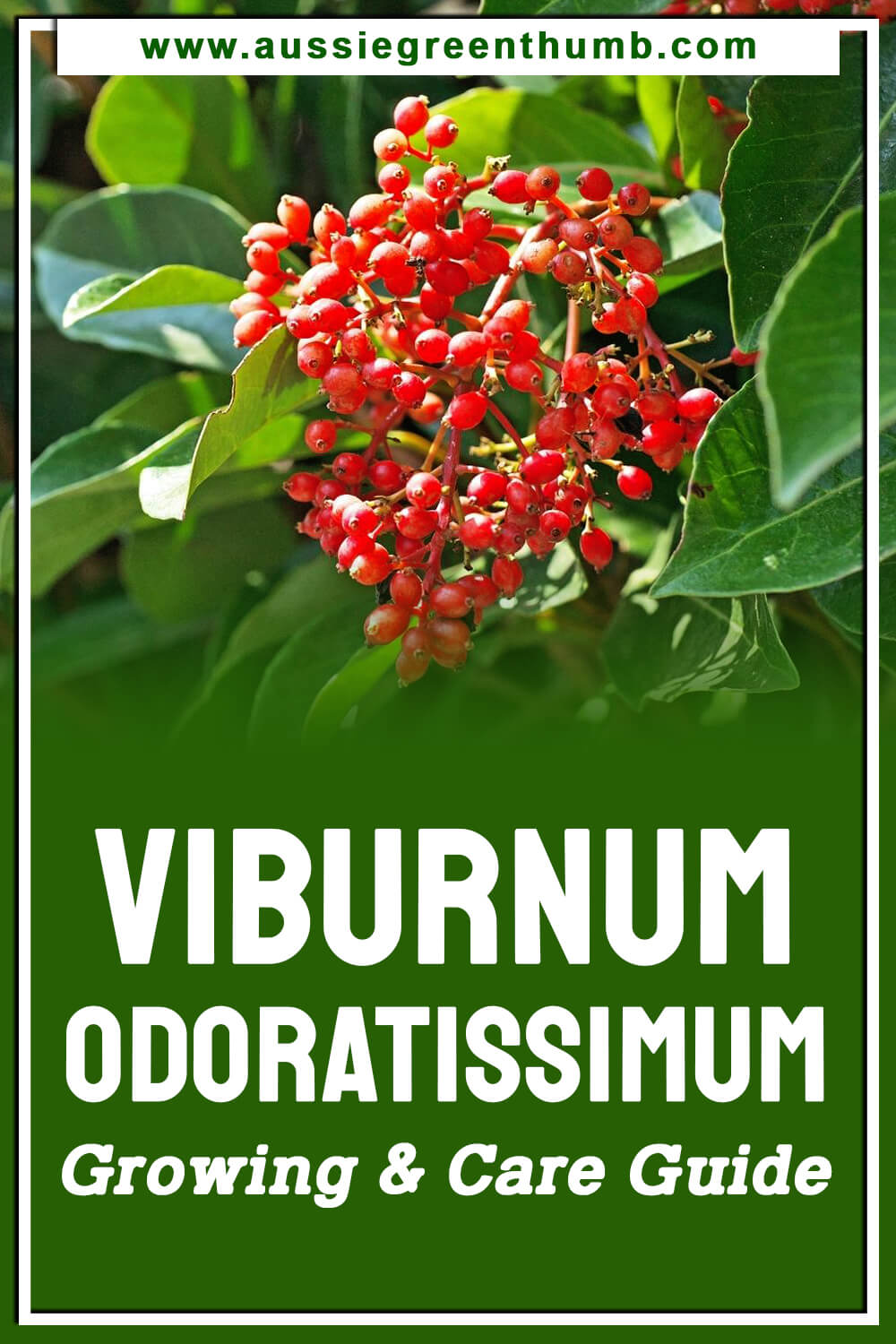
Grow Beautiful Viburnum Odoratissimum Hedge in Your Garden
Viburnum odoratissimum is one of the easiest plants to grow, and unlike traditional box hedging has no common diseases in Australia so will probably outlive you and the rest of your garden by a few decades at least.
These bulletproof sweet viburnums make excellent feature trees and can be pruned into formal hedging so can work in almost any garden. That is everything you need to know to grow and care for Viburnum odoratissimum.
Published on May 1, 2022 by Maisie Blevins
Last Updated on September 19, 2024

